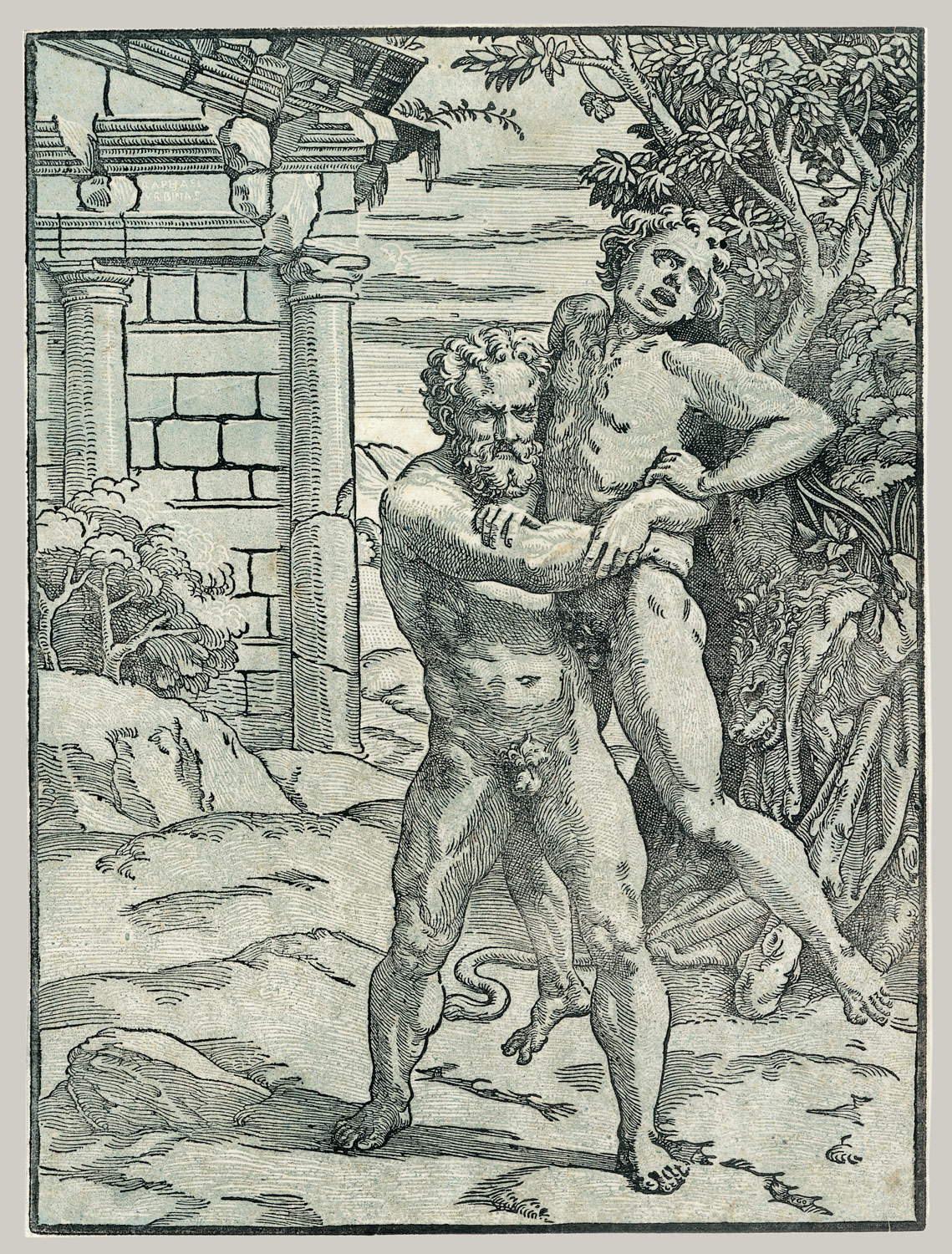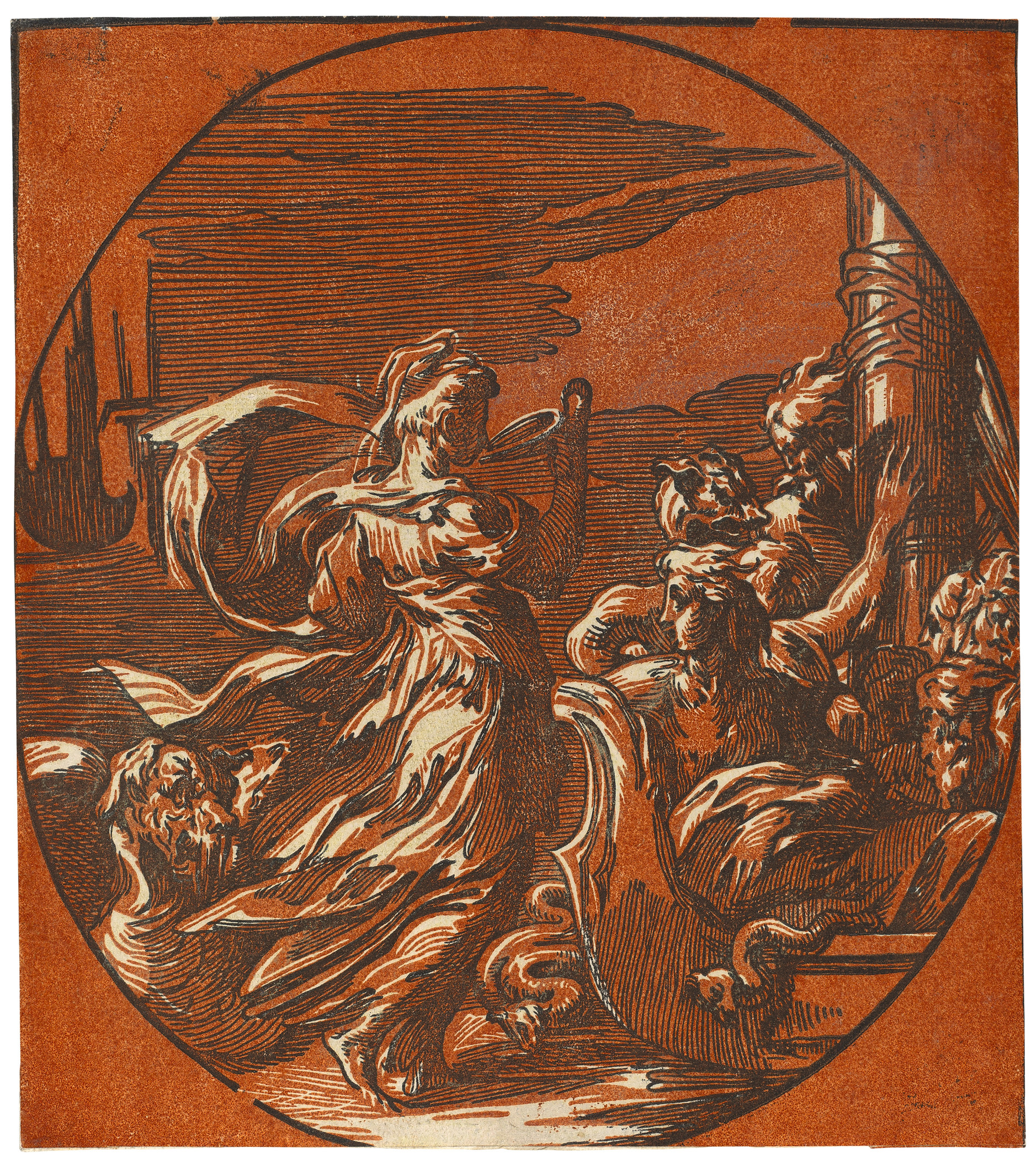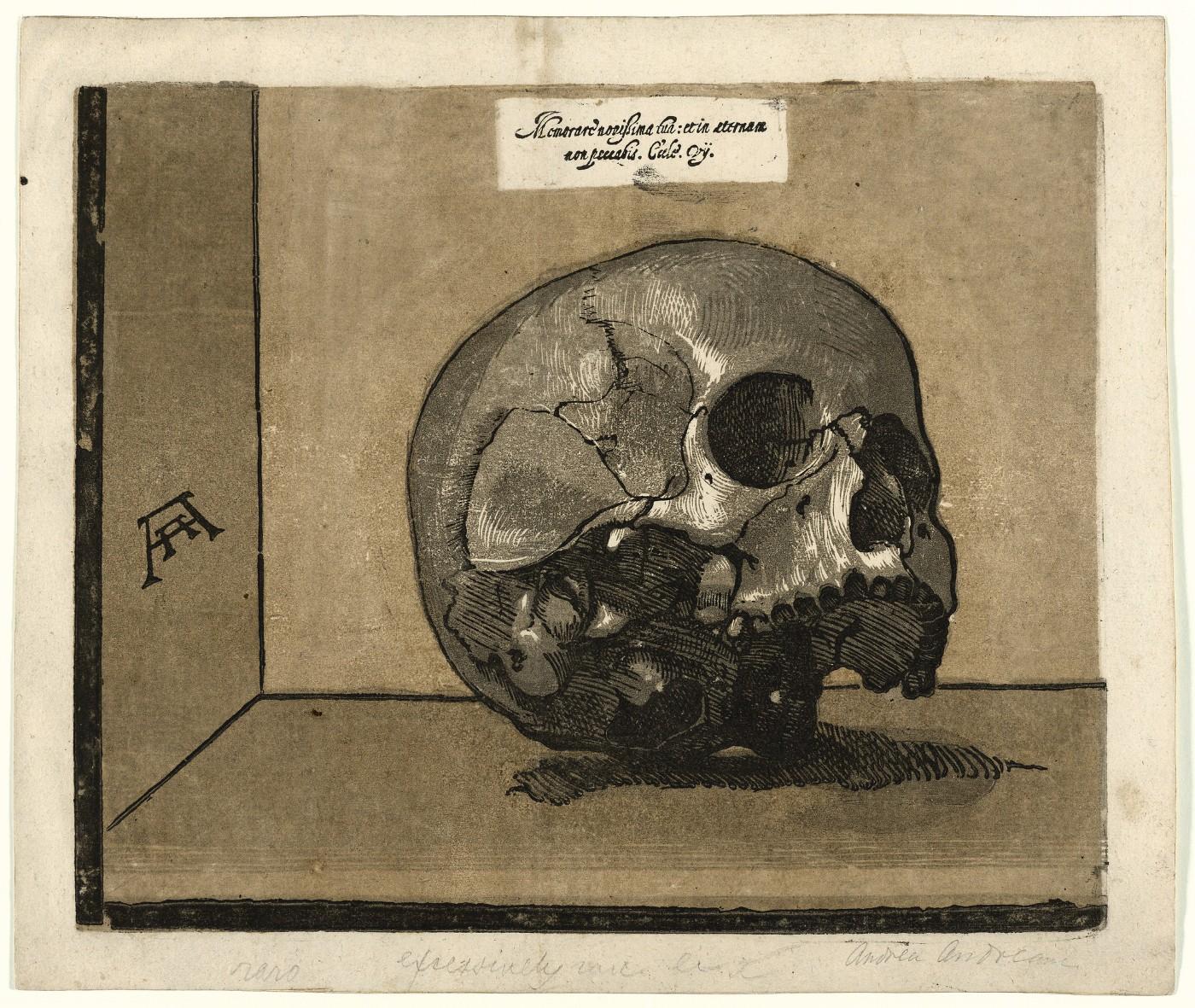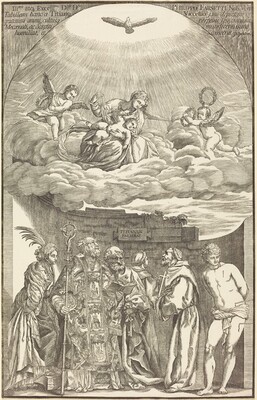Los Angeles County Museum of Art
June 3, 2018–September 16, 2018
National Gallery of Art in Washington, D.C.
October 14, 2018–January 20, 2019
National Gallery of Art in Washington, D.C.
October 14, 2018–January 20, 2019
Displaying exquisite designs, technical virtuosity, and sumptuous color, chiaroscuro woodcuts are among the most striking prints of the Renaissance. First introduced in Italy around 1516, the chiaroscuro woodcut, which involves printing an image from two or more woodblocks inked in different hues, was one of the most successful early forays into color printing in Europe. Taking its name from the Italian for “light” (chiaro) and “shade” (scuro), the technique creates the illusion of depth through tonal contrasts.
Over the course of the century, the chiaroscuro woodcut underwent sophisticated technical advancements in the hands of talented printmakers such as Ugo da Carpi, Antonio da Trento, Niccolò Vicentino, Nicolò Boldrini, and Andrea Andreani, and engaged some of the most celebrated painters of the time, including Titian, Raphael, and Parmigianino. The medium evolved in format, scale, and subject, testifying to the vital interest of artists and collectors in the range of aesthetic possibilities it offered.
For this first major presentation of the subject in the United States, some 100 rare chiaroscuro woodcuts will be brought together alongside related drawings, engravings, and sculpture. With its accompanying scholarly catalogue, The Chiaroscuro Woodcut in Renaissance Italy explores the materials and means of its production, offering a fresh perspective on the remarkable art of the chiaroscuro woodcut.
Niccolò Vicentino, after Pordenone, Saturn, c. 1540s, chiaroscuro woodcut from 4 blocks in taupe, medium blue-gray, dark blue-gray, and black, state i/iii, 12 5/8 × 17 1/4 in., The British Museum, London, 1858,0417.1577, photo © 2018 The Trustees of the British Museum.
- Nicolò Boldrini, after Raphael
- Hercules and the Nemean Lion
- c. 1566
- chiaroscuro woodcut printed from two blocks in tan and black ink on buff laid paper
National Gallery of Art- sheet: 29.6 × 41.3 cm (11 5/8 × 16 1/4 in.)
mount: 37 × 48.2 cm (14 9/16 × 19 in.) - Passavant, no. 18
- Pepita Milmore Memorial Fund
- 2014.1.1
- John Baptist Jackson after Titian
- The Virgin in Clouds and Six Saints
- 1742
- chiaroscuro woodcut in black [trial proof of line block]
- National Gallery of Art
- Kainen 1962, no. 26, State (trial proof of line block)
- Rosenwald Collection
- 1946.11.71
The Los Angeles County Museum of Art (LACMA) presents The Chiaroscuro Woodcut
in Renaissance Italy , the first major exhibition on the subject in the United
States. Organized by LACMA in association with the National Gallery of Art Washington,
this groundbreaking show brings together some 100 rare and seldom - exhibited chiaroscuro
woodcuts alongside related drawings, engravings, and sculpture, selected from
19 museum collections.
With its accompanying scholarly catalogue, the exhibition explores the creative and technical history of this innovative, early color printmaking technique, offering the most comprehensive study on the remarkable art of the chiaroscuro woodcut.
With its accompanying scholarly catalogue, the exhibition explores the creative and technical history of this innovative, early color printmaking technique, offering the most comprehensive study on the remarkable art of the chiaroscuro woodcut.
Displaying exquisite designs, technical virtuosity, and
sumptuous colo r, chiaroscuro woodcuts are among the most visually arresting and
beautiful prints of the Renaissance. First introduced in Italy around 1516, the
chiaroscuro woodcut was the most successful early foray into color printing in
Europe. Taking its name from the Italian terms for “light” ( chiaro ) and “ dark
” ( scuro ), the technique involves printing an image from two or more
woodblocks inked in different hues, employing tonal contrasts to create three -
dimensional effects .
A distinctive characteristic of the tech nique was the ability to print the same image in a variety of palettes. Over the course of the century, the chiaroscuro woodcut engaged some of the most celebrated painters and draftsmen of the time, including Titian, Raphael, and Parmigianino , and underwent sophisticated technical advancements in the hands of talented printmakers active throughout the Italian peninsula.
The medium evolved in subject, format, and scale, testifying to the vital fascination among artists and collectors in the ran ge of aesthetic possibilities it offered. Embraced as a means of disseminating designs and appreciated as works of art in their own right, these novel prints exemplify the rich imagery and technical innovation of the Italian Renaissance.
The Chiaroscuro Woodcut is organized chronologically , exploring the contributions of the major Italian workshop s to chart the technique ’s development through the 16 th century .

Ugo da Carpi, after Parmigianino, Diogenes, c. 1527–1530. Chiaroscuro woodcut from four blocks in light blue, green-blue, green, and gray, state i/iii, sheet: 18 3/4 x 13 3/4 in. Blanton Museum of Art, The University of Texas at Austin, Purchase through the
It begins with Ugo da Carpi, the Italian progenitor of the technique, and his work in Venice and Rome (c. 1516 – 27 ).
It continues to the workshops of Parmigianino in Bologna (1527 – 30); Niccolò Vicentino (c. 1540s); Domenico Beccafumi in Siena (c. 1540s); the dissemination of the technique in smaller workshops throughout the Italian peninsula (c. 1530s – 80s); and concludes with Andrea Andreani in Florence, Siena, and Mantua (c. 1580s – 1610).
A distinctive characteristic of the tech nique was the ability to print the same image in a variety of palettes. Over the course of the century, the chiaroscuro woodcut engaged some of the most celebrated painters and draftsmen of the time, including Titian, Raphael, and Parmigianino , and underwent sophisticated technical advancements in the hands of talented printmakers active throughout the Italian peninsula.
The medium evolved in subject, format, and scale, testifying to the vital fascination among artists and collectors in the ran ge of aesthetic possibilities it offered. Embraced as a means of disseminating designs and appreciated as works of art in their own right, these novel prints exemplify the rich imagery and technical innovation of the Italian Renaissance.
The Chiaroscuro Woodcut is organized chronologically , exploring the contributions of the major Italian workshop s to chart the technique ’s development through the 16 th century .
Ugo da Carpi, after Parmigianino, Diogenes, c. 1527–1530. Chiaroscuro woodcut from four blocks in light blue, green-blue, green, and gray, state i/iii, sheet: 18 3/4 x 13 3/4 in. Blanton Museum of Art, The University of Texas at Austin, Purchase through the
It begins with Ugo da Carpi, the Italian progenitor of the technique, and his work in Venice and Rome (c. 1516 – 27 ).
It continues to the workshops of Parmigianino in Bologna (1527 – 30); Niccolò Vicentino (c. 1540s); Domenico Beccafumi in Siena (c. 1540s); the dissemination of the technique in smaller workshops throughout the Italian peninsula (c. 1530s – 80s); and concludes with Andrea Andreani in Florence, Siena, and Mantua (c. 1580s – 1610).
Ugo da Carpi
In 1516, Ugo claimed he had discovered a “new method of printing in chiaro
et scuro [ light and dark ], ” and applied for a privilege from the Venetian
Senate that would protect the process against copyists. Although Northern
European artists had developed the technique a decade earlier, this
hardly diminishes the significance of Ugo’s contribution to the medium ,
which was to become mo st widely practiced in Italy.
Through his technical
proficiency and distinguished associations with Titian in Venice and Raphael in
Rome, Ugo created chiaroscuro woodcuts of remarkable aesthetic sophistication
and forged a new market for these prints. Within a brief period, he advanced
the technique from a basic two - block linear mode
![Image result for [[["xjs.sav.en_US.lxRHmxI2TrQ.O",5]],[["id","type","created_timestamp","last_modified_timestamp","signed_redirect_url","dominant_color_rgb","tag_info","url","title","comment","snippet","image","thumbnail","num_ratings","avg_rating","page","job"]],[["dt_fav_images"]],10000]](https://i.pinimg.com/originals/b3/a2/5c/b3a25cd70254797958450db562e138eb.jpg)
Ugo da Carpi, after Raphael or Giulio Romano, Hercules and the Nemean Lion, c. 1517–18, chiaroscuro woodcut from 2 blocks in blue and black, 11 3/4 × 8 5/8 in., The British Museum, London, 1920,0420.20, photo © 2018 The Trustees of the British Museum
(Hercules and the Nemean
Lion, after Raphael or Giulio Romano, c. 1517 – 18), to a more complex tonal
approach using as many as four blocks
(Aeneas and Anchises, after Raphael, 1518).
Ugo occasionally collaborated directly with a designer.
His Saint Jerome, c. 1516, transmits the vitality of Titian’s energetic draftsmanship, which may have been laid down by the artist onto the block or transferred from a drawing.

Hercules and Antaeus
Artist: Ugo da Carpi (Italian, Carpi ca. 1480–1532 Bologna)
Artist: After Raphael (Raffaello Sanzio or Santi) (Italian, Urbino 1483–1520 Rome)
Date: 1510–30
Medium: Chiaroscuro woodcut printed from two blocks in green-blue and black ink
Dimensions: Sheet: 11 15/16 x 8 7/8 in. (30.3 x 22.6 cm)
Classification: Prints
Credit Line: Rogers Fund, 1922
Metropolitan Museum of Art, Accession Number: 22.67.80
Artist: After Raphael (Raffaello Sanzio or Santi) (Italian, Urbino 1483–1520 Rome)
Date: 1510–30
Medium: Chiaroscuro woodcut printed from two blocks in green-blue and black ink
Dimensions: Sheet: 11 15/16 x 8 7/8 in. (30.3 x 22.6 cm)
Classification: Prints
Credit Line: Rogers Fund, 1922
Metropolitan Museum of Art, Accession Number: 22.67.80

Hercules holding Antaeus by the waist and lifting him off his feet
- Artist:
- Marcantonio Raimondi (Italian, Argini (?) ca. 1480–before 1534 Bologna (?))
- Artist:
- After Raphael (Raffaello Sanzio or Santi) (Italian, Urbino 1483–1520 Rome)
- Artist:
- or Giulio Romano (Italian, Rome 1499?–1546 Mantua)
- Date:
- ca. 1520–22
- Medium:
- Engraving
- Dimensions:
- 12 1/16 x 8 3/8 in. (30.6 x 21.2 cm)
- Classification:
- Prints
- Credit Line:
- The Elisha Whittelsey Collection, The Elisha Whittelsey Fund, 1949
- Metropolitan Museum of Art, Accession Number:
- 49.97.121
But he also worked independently, availing himself of engravings as models for
his chiaroscuros ( Ugo da Carpi, after Marcantonio Raimondi, Hercules and
Antaeus , c. 1517 – 18 , and Marcantonio Raimondi, after Raphael, Hercules and
Antaeus, engraving, c. 1517 – 18). While Ugo did not conceive his own designs,
he performed or closely supervised all other aspects of production. His pioneering
works, characterized by an admirable refinement of cutting, ink preparation,
and printing, set the foundation for the technique’s efflorescence in Italy
through the Renaissance.
Francesco Mazzola, called Parmigianino
The painter Francesco Mazzola, called Parmigianino, demonstrated a keen appreciation for prints as a means of disseminating inventions and expressin g be autiful draftsmanship. While his printmaking ventures began in Rome around 1526 , his investment in the practice deepened in Bologna, where he resettled in 1527 (following the sack of Rome ) until his return to his native Parma in 1530. There, he produced his own etchings and began his engagement with chiaroscuro. The chiaroscuro woodcuts issued from Parmigianino’s Bolognese shop match the painter’s graceful draftsmanship with skilled cutting, fine inks, and exacting printing, revealing the intimacy of his collaboration with his two cutters, Ugo da Carpi and Antonio da Trento.

Ugo da Carpi after Francesco Parmigianino, Diogenes, c. 1527, Los Angeles County Museum of Art, gift of Philippa Calnan in memory of her mother Matilda Loeser Calnan, photo © Museum Associates/LACMA
Francesco Mazzola, called Parmigianino
The painter Francesco Mazzola, called Parmigianino, demonstrated a keen appreciation for prints as a means of disseminating inventions and expressin g be autiful draftsmanship. While his printmaking ventures began in Rome around 1526 , his investment in the practice deepened in Bologna, where he resettled in 1527 (following the sack of Rome ) until his return to his native Parma in 1530. There, he produced his own etchings and began his engagement with chiaroscuro. The chiaroscuro woodcuts issued from Parmigianino’s Bolognese shop match the painter’s graceful draftsmanship with skilled cutting, fine inks, and exacting printing, revealing the intimacy of his collaboration with his two cutters, Ugo da Carpi and Antonio da Trento.
Ugo da Carpi after Francesco Parmigianino, Diogenes, c. 1527, Los Angeles County Museum of Art, gift of Philippa Calnan in memory of her mother Matilda Loeser Calnan, photo © Museum Associates/LACMA
Ugo’s masterwork Diogenes, after Parmigianino, (c. 1527 – 30) , an unparalleled achievement in the history of the technique , dates to this period. It depicts the Greek philosopher Diogenes seated before the barrel he made his home with a plucked chicken to the right, which allude s to his mockery of Plato’s description of man as a species of featherless biped .
Working closely with Parmigianino, Ugo orchestrated the designs of four interdependent and overlapping blocks to model the dynamic figure, capture the fluid movement of his drapery, and render the distinctive texture of the fowl’s exposed skin .
In contrast to Ugo’s painterly approach, Antonio’s refined cutting of supple, calligraphic strokes, witnessed in Nude Man Seen from Behind (Narcissus) , after Parmigianino, (c. 1527 – 30), sensitively transmits Parmigianino’s fluent drawing hand. (see below)
Impressions printed in different palettes demonstrate how changes in color not only alter tonal relationships, but equally affect the mood and treatment of a subject. examines the chiaroscuros of the most prolific Renaissance workshop.
Vicentino
While little biographic information is known about Vicentino, his name implies origins in the Veneto, and Giorgio Vasari (the 16 th - century artists’ biographer ) placed his activity after Parmigianino’s death in 1540.
Although some uncertainty has surrounded the attribution of many of Vicentino’s unsigned prints, study of cutting techniques , printing characteristics, and publishing histories provides new grounds for establishing his workshop’s oeuvre.
Most of his chiaroscuros were modeled on Italian designs from the mid - 1510s to the late 1530s, primarily ones by Parmigianino

( Circe Drinking [ Circella ] , after Parmigianino, c. 1540s )

and Raphael (attributed to Raphael, Miraculous Draught of Fishes, c. 1514 , and

Attributed to Niccolò Vicentino (fl. c.1530–50) after Raphael (1483–1520)
The Miraculous Draught of Fishes c.1540
Chiaroscuro woodcut, printed from three blocks |
25.5 x 36.6 cm |
RCIN 853019
Vicentino, Miraculous Draught of Fishes, after Raphael, c. 1540s ).
However, as Vicentino commonly worked from drawings independently of their creators, the chronology of his output remains unclear. Vicentino’s workshop introduced strikingly bold, saturated colors to the Italian chiaroscuro woodcut as evidenced in multiple impressions of Saturn, after Pordenone, c. 1540s, and its production prioritized expediency, pointing to the technique ’s increased commercialization. The substantial survival of impressions in diverse palettes testifies at once to the success of Vicentino’s practice and to the broadening audience for Italian chiaroscuro woodcuts.
Domenico Beccafumi
The foremost artistic personality of his native Siena, Beccafumi was charged with many of the city’s most prestigious commissions for paintings, marble inlay designs, and sculpture. He turned to printmaking late in his life, producing nine pure chiaroscuro woodcuts and six engravings printed with tonal woodblocks. Among Italian chiaroscurists, he is unique for having designed and cut his own blocks, and his prints are immediate, spirited expressions of his remarkable vision. The artist probed the possibilities of the chiaroscuro process at each stage of production. He used unconventional tools for cutting, resorted occasionally to printing by hand, and exploited fully the technique’s inherent potential for variation, changing the manner he inked and printed his blocks .
Among his most mature works are his closely related
![Image result for [[["xjs.sav.en_US.lxRHmxI2TrQ.O",5]],[["id","type","created_timestamp","last_modified_timestamp","signed_redirect_url","dominant_color_rgb","tag_info","url","title","comment","snippet","image","thumbnail","num_ratings","avg_rating","page","job"]],[["dt_fav_images"]],10000]](https://imgc.artprintimages.com/img/print/domenico-beccafumi-an-apostle-between-1500-and-1552_u-l-puixtb0.jpg?src=gp&w=300&h=300)
Apostle with a Book
![Image result for [[["xjs.sav.en_US.lxRHmxI2TrQ.O",5]],[["id","type","created_timestamp","last_modified_timestamp","signed_redirect_url","dominant_color_rgb","tag_info","url","title","comment","snippet","image","thumbnail","num_ratings","avg_rating","page","job"]],[["dt_fav_images"]],10000]](https://render.fineartamerica.com/images/rendered/search/framed-print/images-medium-5/st-philip-between-1500-and-1552-beccafumi-domenico-1486-1551-italian.jpg)
and Saint Philip ( both c. 1540s) , which are striking for their ambitious scale, bold palette, and palpably energetic cutting that assert the material of the wood Like his paintings and drawings, his prints display his fertile invention, bold draftsmanship, and fluent expression of dramatic chiaroscuro. reveals how, alongside the major practitioners, other Italian painters and printmakers also explored the chiaroscuro woodcut to great creative ends. The designs of Titian, Raphael and his circle, and Parmigianino, which were vital to the development of the technique, continued to be important sources through the middle of the century.
However, as enthusiasm for the novel technique spread to new artistic centers throughout the peninsula, different styles and manners were espoused. Notably, the painters Antonio Campi, Federico Barocci, and Marco Pino (Giovanni Gallo, after Marco Pino, Holy Family with the Infant Saint John the Baptist , 1570s – 80s ) introduced the technique to Cremona, Urbino, and Naples, cities that were not major print publishing centers.
Nicolò Boldrini
Moreover, the introduction of new subjects, including landscape and genre by printmakers such as Nicolò Boldrini, discloses a continued ambition to innovate. Boldrini ’s magnificent Tree with Two Goats, late 1560s, is the only treatment of pure landscape in Italian chiaroscuro Production in these smaller workshops, often by artists and printmakers who engaged only occasionally with the technique, was generally limited in numbers.
Yet despite more episodic and attenuated production , the appreciation for chiaroscuro woodcuts was undoubtedly sustained through these decades. Crucially, as the century advanced, the great variety of prints that became available elicited critical standards in their appreciation among an ever more discerning audience.
Andrea Andreani
In a career spanning three decades, printmaker Andrea Andreani produced some 35 chiaroscuro woodcuts. He primarily took up the designs of artists in the various centers of his activity — namely Florence, Siena, and his native Mantua — working with esteemed living artists and adopting the inventions of great masters of earlier generations.
This section explores the printmaker who displayed a remarkable talent for establishing artistic connections and cultivating the favor of an elite local patronage.
Andreani always acted as his own publisher, and his output appears aimed principally at high - end collectors and art connoisseurs. Andreani brought great ambition to the medium, quickly becoming its most accomplished practitioner of late century. Notably, he produced the first chiaroscuro woodcuts in Italy composed from two or more sheets from multiple sets of blocks. These prints achieve a grand pictorial scale that rivals the impact of painting, signaling an important shift in function and taste.

Andrea Andreani, after Giovanni Fortuna (?), A Skull , c. 1588, chiaroscuro woodcut from 5 blocks in light brown, light gray, medium gray, dark gray, and black, The British Museum, London, 1861,0518.199, photo © 2018 The Trustees of the British Museum
Three different views of
The Rape of the Sabine Women
(153) By Giambologna.
Loggia dei Lanzi in Florence.
Giambologna’s famous Florentine marble sculpture, Rape of a Sabine, were both Andreani’s first chiaroscuro woodcuts as well as the earliest Italian ones to record a sculptural work

The Rape of a Sabine. about 1584. Andrea Andreani (Italian, 1558/59–1629), After Giambologna (Jean Boulogne) (Flemish (worked in Italy), 1529–1608) ..
After 1600, Andreani shifted his practice to republish the chiaroscuro woodcuts of an earlier generation of printmakers. These final years of his career were spent looking back at the chiaroscuro medium, which he himself had brought to new levels of technical and visual refin ement. A vital aspect of the scholarly research were collaborative studies by art historians, conservators, and conservation scientists that explored the materials and means of chiaroscuro production .
The Chiaroscuro Woodcut in Renaissance Italy is the first exhibition on the subject to integrate such interdisciplinary , technical research. LACMA’s presentation features findings from the conservation and material science investigations , including examples of some of the commonly used ink colorants , recreations of the printing process, and an overview of an extensive conservation treatment endeavor.

The Chiaroscuro Woodcut in Renaissance Italy by Naoko Takahatake (Editor), with contributions by Jonathan Bober , Jamie Gabbarelli , Antony Griffiths , Peter Parshall , and Linda Stiber Morenus. Featuring more than 100 prints and related drawings, this book documents a decade of pioneering interdisciplinary research , combining studies from the fields of art history, conservation, and material science to present the first comprehensive assessment of the subject. Essays and entries by noted scholars trace the chiaroscuro woodcut’s creative origins , evolution , and recep tion , and provide authoritative interpretations of their materials and means of production. Brimming with full - color illustrations of rare , exquisite works, this groundbreaking study offers a fresh interpretation of these remarkable prints, which exemplify the beauty and innovation of Italian Renaissance art
![Image result for [[["xjs.sav.en_US.lxRHmxI2TrQ.O",5]],[["id","type","created_timestamp","last_modified_timestamp","signed_redirect_url","dominant_color_rgb","tag_info","url","title","comment","snippet","image","thumbnail","num_ratings","avg_rating","page","job"]],[["dt_fav_images"]],10000]](https://unframed.lacma.org/sites/default/files/attachments/EX8410_093and73.jpg)
(Left)
Antonio da Trento, after Parmigianino, Nude Man Seen from Behind (Narcissus) , c. 1527 – 30, chiaroscuro woodcut from 2 blocks in green and black, Harvard Art Museums/Fogg Museum, Gray Collection of Engravings Fund, G7500, photo: Imaging Department © 2018 President and Fellows of Harvard College;
and
(Right)
Antonio da Trento, after Parmigianino, Nude Man Seen from Behind (Narcissus) , c. 1527 – 30, chiaroscuro woodcut from 2 blocks in light brown and black, Philadelphia Museum of Art, The Muriel a nd Philip Berman Gift, acquired from the John S. Phillips bequest of 1876 to the Pennsylvania Academy of the Fine Arts, with funds contributed by Muriel and Philip Berman, gifts (by exchange) of Lisa Norris Elkins, Bryant W. Langston, Samuel S. White 3rd a nd Vera White, with additional funds contributed by John Howard McFadden, Jr., Thomas Skelton Harrison, and the Philip H.and A.S.W. Rosenbach Foundation, 1985, 1985 - 52 - 556, photo courtesy Philadelphia Museum of Art;

